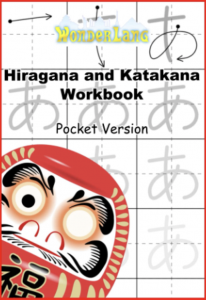Hello,
In this article we will discover the different alphabets of the Japanese language. Let’s getting started!
| Amazon.com |  |
Amazon.ca |
One of the major steps when studying Japanese is to master the Japanese writing system. This, as you will quickly see, will be a long task, sometimes even tedious, that you will have to perform step by step. But be sure that each step will bring its rewards.
Take a look at the following example:
私はケビンです。
This short sentence, which is pronounced “Watashi wa Kebin desu.” and means “I am Kevin.”, offers a digest of the specificities of the Japanese writing system. By having a quick look at this sentence we can identify 3 types of character: the first one looks round and simple (は,で,す) and is called hirakana, the second one is also simple but looks shaper (ケ,ビ,ン) and is called katakana, and the last one contains complex characters (私) which are called kanji. Hiragana and katakana altogether are called kana.
Hiragana and katakana are two syllabaries, which means that each character represents (generally) a syllable and not just a single letter. Both of them are composed of 46 characters and are the basis to be able to read simple Japanese texts, but are also present in everyday life.
Kanji on their side were characters taken from the Chinese Han writing system. These characters were initially logograms, that is to say they represented objects or concepts taken from everyday life (a tree, a bird, resting…), with a predefined Chinese pronunciation. What make things tricky when learning kanji – this is the tedious part I spoke of – if we take apart the fact that their structure may vary from 1 single stroke to more than 30 strokes for some of them, is that Japanese people re-used for part the Chinese symbols to image their own Japanese words (this is what is called kun-yomi, or semantic reading), and for others reused the Chinese characters for their pronunciation to construct representation for some Japanese words (this is what is called on-yomi, or phonetic reading). In the end most of the kanji have multiple pronunciations and people have to know each of them to be able to properly read Japanese. For instance, 私 which has 7 strokes and means “me”, “I”, “private”, can be pronounced “watakushi”, “watashi” or “SHI”. The list of kanji that people shall master to be able to read most common documents is defined by the Japanese Government and is at the moment composed of 2,136 characters. But for the motivated ones, know that there exists in total more than 50,000 characters. For the fun fact too note that Japanese could be written using only kanji, but this form of writting Japanese is rare in everyday life.
Another important thing to know when learning Japanese is that there exists different transcription systems, called romaji, to represent Japanese pronunciation using the roman alphabet. One of the most commonly used nowadays is the Hepburn system. This is the system I used to show the pronunciation of the example above as well as for the different technical terms (kana, hiragana…) and that I will use all along the Japanese lessons and articles.
Finally you may have spotted that the Japanese writing system uses its own punctuation symbols such as “。” to represent the full stop at the end of a sentence, but I will not go any further on this subject for the moment.
For a quick presentation of the romaji alphabet, please have a look at the following post: Romaji.
Then to go further in learning reading and writing Japanese you will find:
- Introduction to Hiragana and Katakana: this lesson is the entry point to lessons on learning hiragana and katakana.
- Introduction to Kanji (not yet available): this lesson will further introduce kanji and be your entry point to learning them.
Stéphane
Follow us: